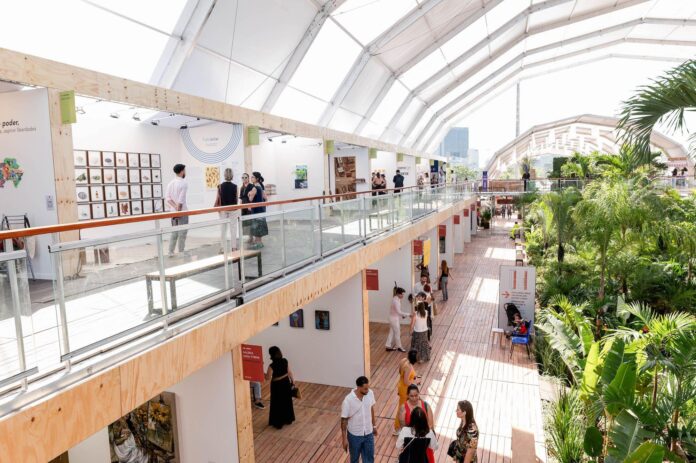ArtRio opened its 13th edition in Rio de Janeiro this week, with a noticeable uptick in participation from international galleries at its photogenic location on the shore of the city’s Guanabara Bay at Marina da Glória. According to organisers, the fair this year boasts 25% more space for the 80 galleries participating, a significant bump from the 62 that took part in 2022—which was its first full-scale edition since before the pandemic.
“What kept our fair going these last few years was the national market, but now I feel a new interest from international galleries and my expectation is that we can gradually open up this international market again, bringing to Rio de Janeiro these galleries while also showing our artists to international players,” Brenda Valansi, ArtRio’s founder and president, tells The Art Newspaper.
According to the most recent edition of Art Basel and UBS’s annual report The Art Market, sales within South America accounted for the overwhelming majority (81%) of Brazilian dealers’ sales in 2022. The post-Covid-19 rebound in the country’s art market also slowed significantly in 2022, to just 1% growth year-on-year—in 2021, South American dealers’ sales surged 29%.
“We are experiencing a renewal of our international role both in the number of international galleries but also the number of foreign collectors, curators and visitors coming to this year’s ArtRio,” Valansi says.

A 1932 painting by Pedro Figari on view in Sur Galeria’s ArtRio stand Sur Galeria
This year’s fair features a small but significant cohort of six international exhibitors from Uruguay, the United States, Italy and Portugal. One of them is Sur Galeria from Maldonado, Uruguay. Absent from the fair since 2020, Martin Castillo, the gallery’s co-founder, says it was important to return to Rio.
“Brazil has a very strong position in the Latin American art market,” Castillo says. “It is one of the countries that measure the temperature of the region’s art market and ArtRio is unique, because here there is has a very distinct combination of sea and sun.”
Another international gallery participating in ArtRio is Lisbon-based Francisco Fino. The gallery, making its debut at the fair, is showing a solo stand of works by Brazilian painter Priscila Rooxo, a winner of the fair’s Foco Prize last year.
Rooxo has become one of the darlings of Brazilian collectors, for her raw depictions of daily life for people in Rio’s poorer neighbourhoods. “My work talks about gender, territory and class,” she says. “It has a social footprint, with the vision of peripheral women like me.”
The fair is once again divided between Earth and Sea pavilions, the latter gaining a second floor of stands. The exhibitors are divided into five sectors, including Vista—a section in the Sea pavilion devoted to galleries founded in the last ten years—and the Mira programme devoted to works by artists whose work is influenced by cinema. The fair’s sector for solo presentations, located on the lower level of the Sea pavilion and curated for the second consecutive year by curator Ademar Britto, features solo stands from 16 galleries.
“Galleries did an excellent job this edition, bringing very important works of both Brazilian modernism and contemporary art in general,” says Valansi.

ArtRio’s waterfront location in Rio de Janeiro Bruno Ryfer/ArtRio
“ArtRio gave a boost to the Rio art market,” says Sergio Gonçalves, whose namesake gallery is participating for the first time. “Moving the fair to the Marina da Glória was the turning point.” From his stand, Gonçalves can see one of Rio’s most famous postcard views of Sugarloaf Mountain. He adds, “There’s no fair in the world with this view.”
Gonçalves says that many of the artists featured on his stand have never participated in fairs in Rio de Janeiro. “I try not to bring in those artists who are already in the mainstream,” he says. “I really want people to discover new artists. I would like to help form this new generation of future collectors.”
One of the most visited stands during the fair’s preview was that of Belo Horizonte-based Lemos de Sá Gallery, which features a solo presentation of Brazilian artist René Machado’s very sought-after paintings.

Artist Rene Machado in his solo stand at ArtRio with Lemos de Sa Galeria Cristina Granato/ArtRio
“Demand is phenomenal,” Machado says. “The fair is very well structured, and we are receiving visitors from all over.” By the end of the preview day, Machado said one work had sold and there were several reserved by interested buyers.
“ArtRio has the characteristic of being very fresh, very cutting edge,” says Brazilian curator and art critic,.
According to the curator and critic Paulo Herkenhoff—who was the general director of the Museu Nacional de Belas Artes and the first cultural director of the Museu de Arte do Rio—ArtRio brings together all the issues and themes that have defined Brazilian art in the 21st century, including contemporary Indigenous art, art by and about Brazil’s communities of African descent and LGBTQ+ artists.
“All of this coexists in a charming way,” Herkenhoff says. “It’s a tsunami from contemporary Brazil. This is the uniqueness of ArtRio.”
- ArtRio, until 17 September, Marina da Glória, Rio de Janeiro

























